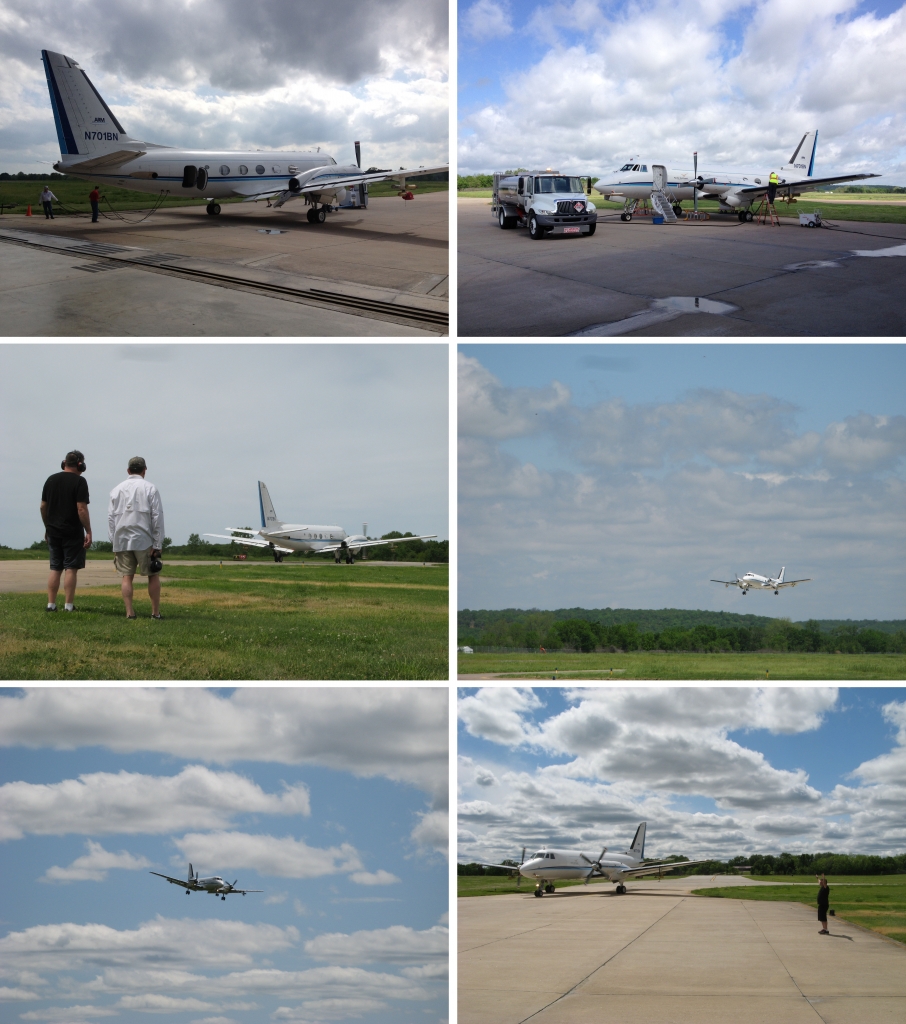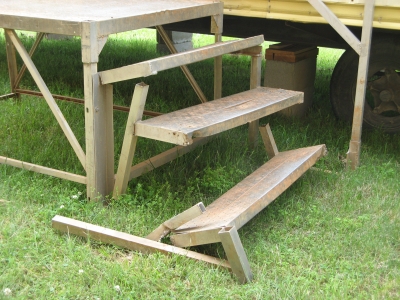HI-SCALE Week 1: It’s a Wrap
Published: 3 May 2016
Editor’s note: Siegfried Schobesberger, a postdoctoral researcher at University of Washington, sent this update.
After 7 days of hard work, the first week of the HI-SCALE campaign has already passed! We managed a total of four research flights—experiencing a few hiccups, but collected interesting data!

Bottom right: Mike Crocker is receiving the plane on the ramp in front of the hangar.
Monday, April 25, took our first flight. The G-1 took off from Bartlesville around 11 a.m., for a 3.5 hour flight, which is the typical length time of the flights we are doing. In support of the ground-based measurements at the Southern Great Plains site, we flew transects at various levels upwind from the station (to the south) and to and from it, and we got to fly through low clouds. Even though it was the first flight, the airborne instrumentation worked well.
As expected, it also revealed where there is still room to improve our setups and what to watch for to keep things running smoothly. For instance, air temperature (on the ground) rose to above 80°F that day, and the fancy equipment we stuffed inside the G-1 produces a lot of extra heat (e.g., from pumps), so much that the air-conditioning units on the aircraft can barely keep up. So, the cabin heated up to well over 90°F. Several instruments can get into trouble at such high temperatures, especially if they rely on sensitive electronics that can overheat and create unacceptable electrical noise or simply shut down to protect them.
Tuesday, April 26, we spent half of the day fixing those little problems with our instruments and half with looking at radar images to observe the storms starting to develop around us. The forecasters had promised us severe thunderstorms (and possibly tornadoes) in the Oklahoma/Kansas area, so our crowd of atmospheric scientists was naturally excited about the chance to witness some forces of nature. And, indeed we did get some well-developed thunderstorms over Bartlesville! Unfortunately it took them until after 10 p.m. to get here, so there wasn’t much to see (no pictures from my little camera).
It did get interestingly windy though. The next day, we found some evidence of the impressing force of those winds at the airport. One of the stairs that led to the doors of the trailer had been blown 30 feet away, until it came to rest against the airport perimeter fence. Although made of metal, the stairs were completely wrecked (see photo). We are still wondering how exactly that happened…

Wednesday and Thursday, April 27 and 28, were flight days again. The thunderstorms left behind very clear air. Only a small amount of aerosol particles were seen (that are often visible, for instance as dust or haze), and sunny weather conditions that lead to regional-scale events of atmospheric “new particle formation.”*
Friday was the weekly prescribed down-day, and Saturday we spent fixing things and calibrating.
Sunday, May 1, was a flight day again, with unusual winds from the north. An initial look at the data indicated some interesting aerosol composition at some places…
Data processing and analysis is in progress. However, generally we spend a lot of time ensuring that all our equipment is working as well as possible for each flight, so it is a challenge to find time to properly look at all the data we collect as promptly as possible, while fast quality assurance checks take precedence.
*New particle formation generally occurs when certain trace gases in the atmosphere stick onto each other, forming new liquid or solid aerosol particles. They are nanometers in size initially, but grow to larger sizes by more and more molecules sticking onto them, until they reach sizes that make them affect clouds, solar radiation and air quality.
Previous research suggests that new particle formation, when observed at the ground or at low altitudes, often occurs on a regional scale, i.e., more or less homogeneously over hundreds of square miles. The sunny skies, mentioned above, help in making this happen: Solar radiation can chemically transform (mainly via oxidation reactions) certain trace gases that have previously been emitted by biological, geological, and human activity, so that they become less volatile and able to stick to surfaces, or even to one another. Clean air also helps by allowing more suitable trace gas molecules to be available because larger dust or haze particles could otherwise absorb too many of those molecules (or also the small fledgling particles that the molecules might have just formed).
The ARM Climate Research Facility is a DOE Office of Science user facility. The ARM Facility is operated by nine DOE national laboratories, including .
Keep up with the Atmospheric Observer
Updates on ARM news, events, and opportunities delivered to your inbox
ARM User Profile
ARM welcomes users from all institutions and nations. A free ARM user account is needed to access ARM data.


















